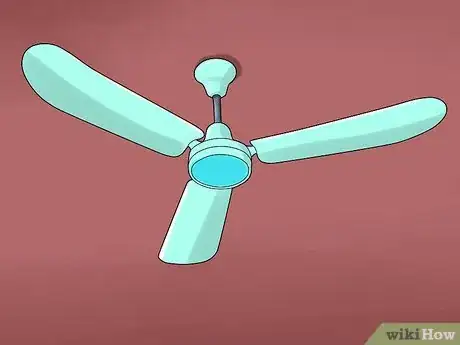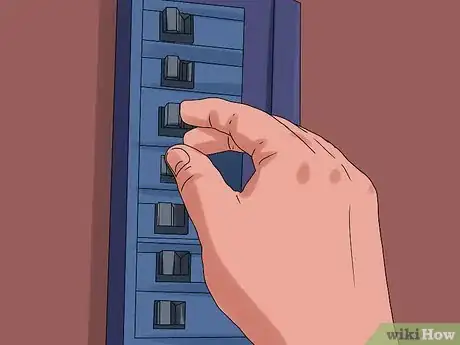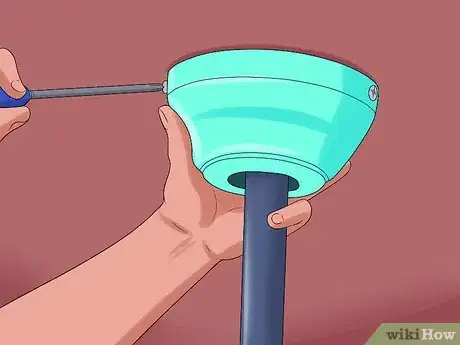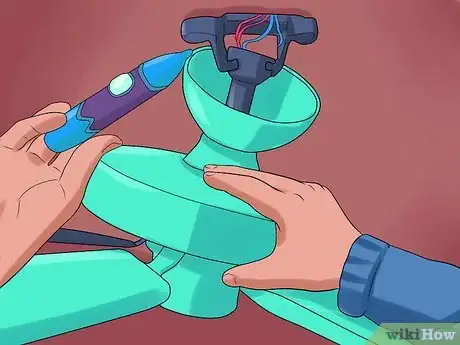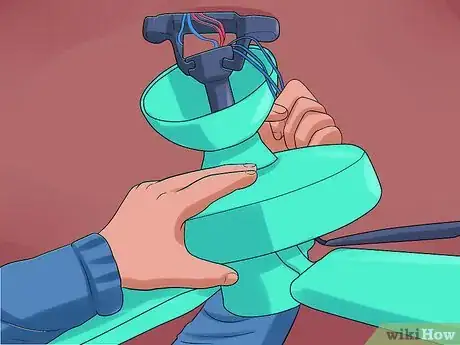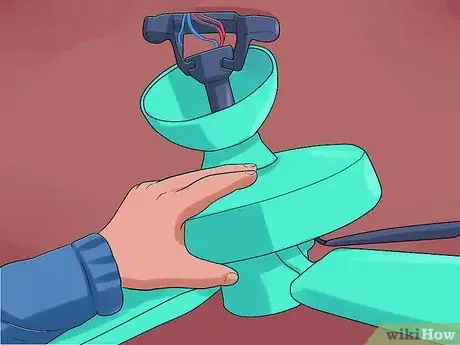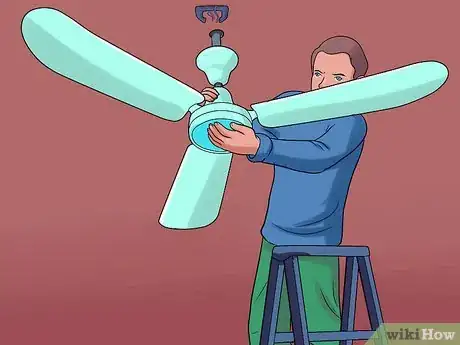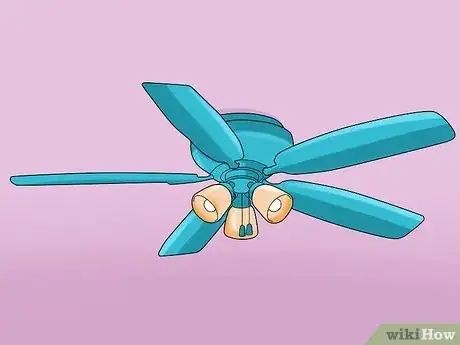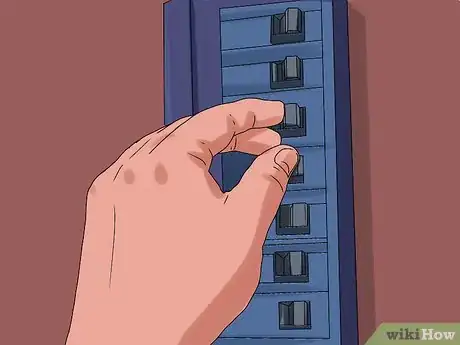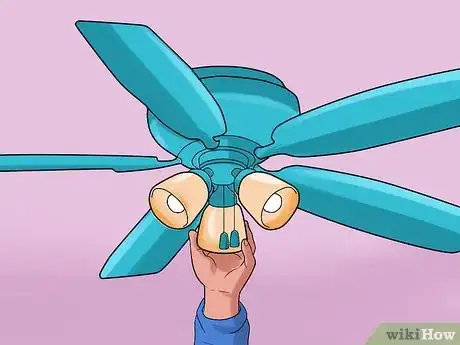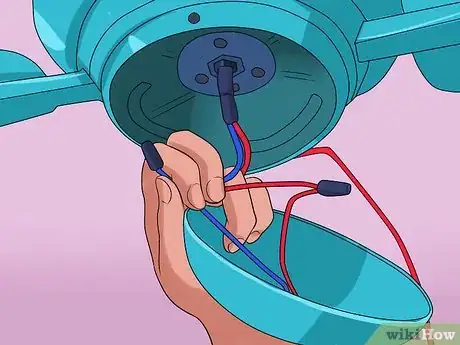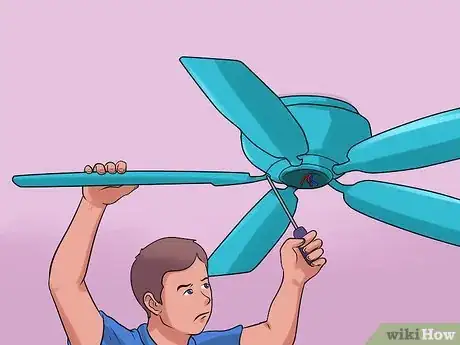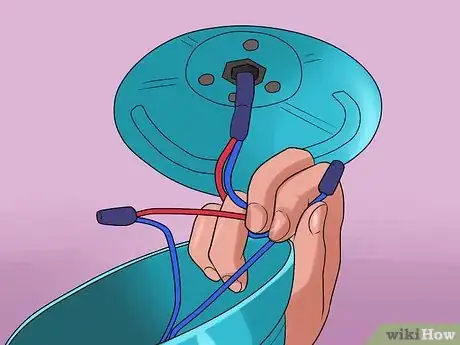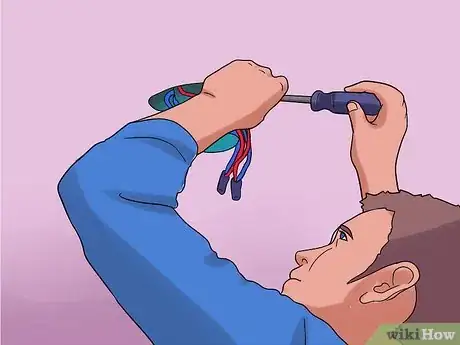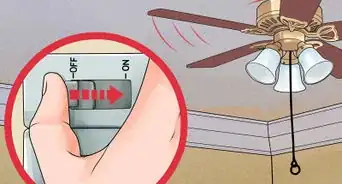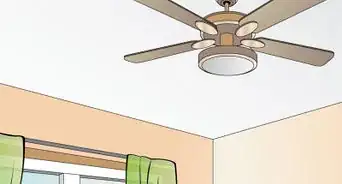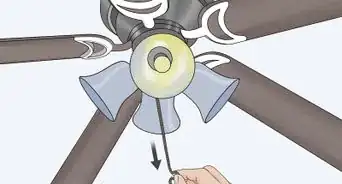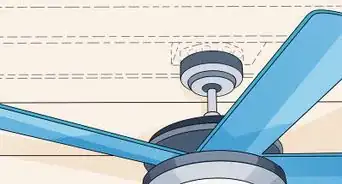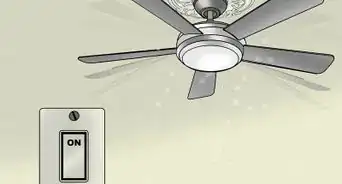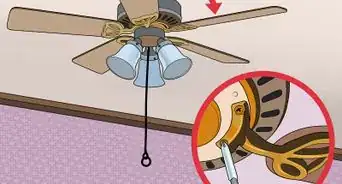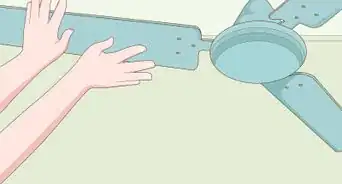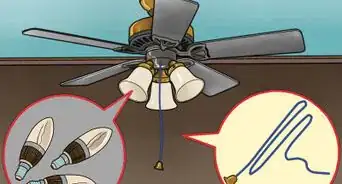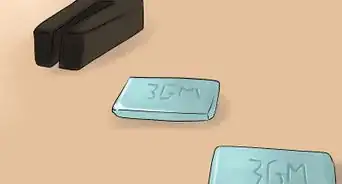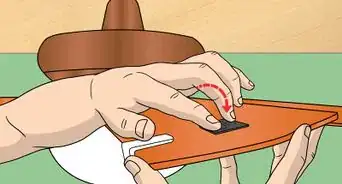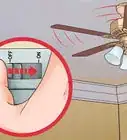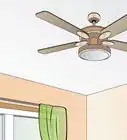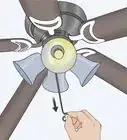This article was co-authored by Allen Lee. Allen Lee is a Home Improvement Specialist and the Owner of Honest Lee Handyman Services, a licensed and insured handyman business servicing Sacramento, California, and surrounding areas. Working with homeowners and businesses to get their small repairs done in a timely and efficient manner, Honest Lee Handyman Services provides gutter and dryer vent cleaning along with fixture, fence, drywall, and toilet repairs.
There are 8 references cited in this article, which can be found at the bottom of the page.
This article has been viewed 286,353 times.
Having a ceiling fan can be a simple and efficient way to move air around any room. They can be a great addition to your home, but once they stop working, or their look becomes outdated, it's important to know how to take them down safely. Most ceiling fans can be easily removed by following one of these methods.
Steps
Removing a Ball-in-Socket Style Ceiling Fan
-
1Assess whether you have a ball-in-socket style ceiling fan, also known as a down-rod mounted ceiling fan. These type of fans are distinctive in that the body of the fan hangs a bit away from the ceiling on a pole.[1] The pole connects at the ceiling at a canopy, which is just a small metal enclosure that covers the mounting bracket and wires for the fan. This type of ceiling fan can usually be easily removed in a few steps.
-
2Always turn off the power at the electrical panel before working on anything electrical. An easy way to make sure you have turned off the power is by keeping the fan on when you go to switch the breaker. If you have successfully turned off the correct breaker, the fan should be coming to a stop when you return.[2]Advertisement
-
3Place your ladder under the ceiling fan. You may want to place it a little to the side of the fan so you can easily reach around the paddles to the canopy at the ceiling.[3]
-
4Remove the metal canopy that covers the mounting bracket by loosening the screws on either side.[4] You may need to use a very short screwdriver to get between the housing at the ceiling and the main body of the ceiling fan. Once the canopy is unscrewed, simply lower it down so it rests on top of the fan body. Now you should be able to see how the ball at the top of the fan pole slips easily in and out of the bracket. You should also be able to see the electrical connections between the fan and the wires in the ceiling.
- If you cannot get into the space between the housing and the fan body, you may want to follow method two below, as it will tell you how to take more parts off the fan apart in order to remove it.
-
5Retest that you have no power coming to the fan. This is most easily done with a non-contact voltage tester, which tests for magnetic fields around wires quickly and easily.
-
6Remove the wire nuts that are connecting the wires from the fan and the wires from the ceiling together.[5] You may need to pull all the wires out a bit to access the wire nuts but once you have them in hand, turn them counterclockwise and they should unscrew.
- Once you have detached the fan wires from the wires coming from the ceiling, be sure to put the wire nuts back onto the wires coming from the ceiling. This way, if you need to turn the power back on before you install a new fixture, your wires will be safely capped off.
-
7Grab a hold of the whole light fixture and slide the ball at the top of the fan pole out of the mounting bracket. This connection might vary slightly, but should slip out relatively easily no matter the exact style. Remember to keep a good hold of the fan, as once its out of the bracket you will need to support its whole weight.
-
8Lower the fan to the ground. It may be helpful to rest it on the top of your ladder momentarily, so that you can readjust your grip and get down your ladder with the fan safely. You now have removed your ceiling fan but you are not quite done!
-
9Detach the mounting bracket from the ceiling. It should be attached with two screws the electrical box in the ceiling. It is a good idea to put the screws back in the electrical box once the bracket is removed so that they are there for the next fixture you want to attach.
- Even if you are going to put up a new ceiling fan, you should still remove the mounting bracket. Every ceiling fan comes with its own mounting bracket that is made specifically for that model.
Removing a Flush Mounted Ceiling Fan
-
1Assess whether you have a flush mounted ceiling fan, also known as a bracket mounted ceiling fan. This type of ceiling fan is obviously flush mounted, meaning that the motor of the fan sits right up at the ceiling. These ceiling fans require a bit more disassembly to remove, as the fan itself needs to be taken apart to get to the attachment bracket. However, they are good fans to have in rooms with low ceilings, as they do not hang down as far as ball-in-socket type ceiling fans.
-
2Always turn off the power at the electrical panel before working on anything electrical. An easy way to make sure you have turned off the power is by keeping the fan on when you go to switch the breaker. If you have successfully turned off the right breaker, the fan should be coming to a stop when you return.[6]
-
3Remove all light bulbs and any bulb covers from the fan, if your ceiling fan has a light kit attached to it.[7] The light kit is simply the portion of the fan that is the light. On most ceiling fans with lights, the light kit is a separate section of the fan that can be removed separately. On many styles of ceiling fans the lightbulbs are simply accessible by climbing up a ladder and unscrewing them but some models require you to take off a cover that encloses the bulb.
- Be gentle when removing the lightbulbs. If they happen to break, you should be cautious when removing a broken lightbulb from the socket.
-
4Remove the light kit, if your ceiling fan has one. While some models will allow you to take the fan body off the ceiling without removing the light kit, most flush mounted ceiling fans require that it is removed, so that you can get to the screws that attach the whole fan to the ceiling. This step will require unscrewing the screws that hold the light kit to the fan body. Inside, you will most likely have to disconnect the wires that connect the light kit to the fan. These should simply be connected with wire nuts, which you turn counterclockwise to unscrew.
- It is a really good idea to retest that you have no power coming to the fan once you have opened up the light kit. This is most easily done with a non-contact voltage tester, which tests for magnetic fields around wires quickly and easily.
-
5Remove the fan blades with a screwdriver.[8] Ceiling fan blades are connected to the body of the fan with metal brackets that screw into the fan body, basically the housing for the fan's motor, and into the fan paddles themselves. It's easiest to keep the fan blade brackets and the fan blades attached and just unscrew the screws that attach the brackets to the fan body. This way, you aren't removing twice as many screws while up on your ladder.
- If you plan on re-using the fan, be sure to keep all the parts. Placing all the parts in a marked bag or envelope is a good idea.
-
6Loosen the screws that hold the fan body to the bracket on the ceiling. Be sure to have a good grip on the fan body while doing this. On most modern ceiling fan models the body is attached to the bracket with a screw on one side and a hinge on the other side. This makes it so that when you unscrew the screw, the body of the fan can hang off the hinge while you disconnect the wiring. Once the screw is unscrewed, simply allow the body of the fan to hang from the hinge on one side. Otherwise you would have to hold the whole fan in one hand and disconnect the wires with the other.
-
7Remove the wire nuts that are connecting the wires from the fan and the wires from the ceiling together.[9] You may need to pull all the wires out a bit to access the wire nuts but once you have them in hand, turn them counterclockwise and they should unscrew.
- Once you have detached the fan wires from the wires coming from the ceiling, be sure to put the wire nuts back onto the wires coming from the ceiling. This way, if you need to turn the power back on before you install a new fixture, your wires will be safely capped off.
-
8Remove the fan body from the hinge on the mounting bracket. It should simply have a piece that slips out of the bracket.
- Often, there will be a safety chain coming from the fan attached to a joist in the ceiling. If so, unhook the safety chain to free the fan.
-
9Detach the mounting bracket from the ceiling. It should be attached with two screws the electrical box in the ceiling. It is a good idea to put the screws back in the electrical box once the bracket is removed so that they are there for the next fixture you want to attach.
- Even if you are going to put up a new ceiling fan, you should still remove the mounting bracket. Every ceiling fan comes with its own mounting bracket that is made specifically for that model.
Community Q&A
-
QuestionHow many wires should be hanging from the ceiling before I put up the new fan?
 Community AnswerYou should have three. There will be either a green or copper wire for the grounding. There is a black wire; this is where the fan's black and red wires connected. There is a white wire; this connects to the white wire in the fan.
Community AnswerYou should have three. There will be either a green or copper wire for the grounding. There is a black wire; this is where the fan's black and red wires connected. There is a white wire; this connects to the white wire in the fan. -
QuestionIf there are no screws to the molding cover over the ball socket, what should I do?
 Community AnswerOften, there is a trim ring covering the screws. I have found this trim ring either unscrews by turning it counterclockwise, or it may be a press on piece that snaps off (with the help of a flat screwdriver blade).
Community AnswerOften, there is a trim ring covering the screws. I have found this trim ring either unscrews by turning it counterclockwise, or it may be a press on piece that snaps off (with the help of a flat screwdriver blade). -
QuestionWhat should I do if the mounting bracket screws are stripped?
 DaverwaterlooCommunity AnswerTry using needle-nosed pliers (or other small pliers) to grab the screw heads and turn them. Once you get the screws turning, you can unscrew them completely from the bracket by hand. You might need to periodically tap on the screws to help them rotate freely.
DaverwaterlooCommunity AnswerTry using needle-nosed pliers (or other small pliers) to grab the screw heads and turn them. Once you get the screws turning, you can unscrew them completely from the bracket by hand. You might need to periodically tap on the screws to help them rotate freely.
Warnings
- Always be sure to turn off the power at the circuit breaker/fuse box any time you are working with electricity.[10]⧼thumbs_response⧽
- Be careful not to let your ceiling fan fall during removal. Keep a good grip on the heavy motor body while the screws holding it up are being loosened.⧼thumbs_response⧽
References
- ↑ http://www.thisoldhouse.com/toh/article/0,,218401-3,00.html
- ↑ http://makelyhome.com/how-to-replace-a-ceiling-fan-part-i/
- ↑ https://www.thisoldhouse.com/ideas/how-to-use-ladder-safely
- ↑ https://youtu.be/1274uaZoD1s?t=37
- ↑ https://youtu.be/KB6e0LZm_Y0?t=68
- ↑ http://makelyhome.com/how-to-replace-a-ceiling-fan-part-i/
- ↑ https://youtu.be/1274uaZoD1s?t=7
- ↑ https://youtu.be/klR1_dUAkpo?t=32
- ↑ https://youtu.be/KB6e0LZm_Y0?t=68
About This Article
To remove a ceiling fan, you'll need to unscrew it from its mounting bracket, disconnect the wires, and remove the bracket. First, make sure you turn off the power at the electrical panel so there’s no risk of the fan spinning while you work. Once you’ve turned off the power, remove any lightbulbs from the fan. If your fan has detachable blades, you should also unscrew them at this point. Then, unscrew the fan from its ceiling bracket. Disconnect the wires attaching the fan to the bracket and set the fan aside. To remove the bracket from the ceiling, unscrew the 2 screws securing it to the ceiling. It’s best to put the screws back into the ceiling once you’ve removed the mounting bracket so you can use them in the future. For more tips, including how to remove a canopy covering your fan’s mounting bracket, read on!
